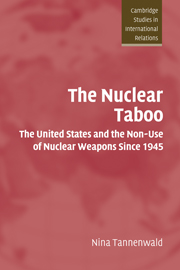Book contents
- Frontmatter
- Contents
- Preface
- List of abbreviations
- 1 Introduction: the tradition of nuclear non-use
- 2 Explaining non-use
- 3 Hiroshima and the origins of the nuclear taboo
- 4 The Korean War: the emerging taboo
- 5 The rise of the nuclear taboo, 1953–1960
- 6 Nuclear weapons and the Vietnam War
- 7 Institutionalizing the taboo, 1960–1989
- 8 The 1991 Gulf War
- 9 The taboo in the post-Cold War world
- 10 Conclusion: the prospects for the nuclear taboo
- Select bibliography
- Index
- CAMBRIDGE STUDIES IN INTERNATIONAL RELATIONS
9 - The taboo in the post-Cold War world
Published online by Cambridge University Press: 22 September 2009
- Frontmatter
- Contents
- Preface
- List of abbreviations
- 1 Introduction: the tradition of nuclear non-use
- 2 Explaining non-use
- 3 Hiroshima and the origins of the nuclear taboo
- 4 The Korean War: the emerging taboo
- 5 The rise of the nuclear taboo, 1953–1960
- 6 Nuclear weapons and the Vietnam War
- 7 Institutionalizing the taboo, 1960–1989
- 8 The 1991 Gulf War
- 9 The taboo in the post-Cold War world
- 10 Conclusion: the prospects for the nuclear taboo
- Select bibliography
- Index
- CAMBRIDGE STUDIES IN INTERNATIONAL RELATIONS
Summary
In every corner of the planet, the tide of public sentiment is now running strongly in favor of diminishing the role of nuclear weapons. Indeed, I am convinced that most publics are well out in front of their governments in shaking off the grip of the Cold War and reaching for opportunities that emerge in its wake.
General George Lee Butler, former commander of the US strategic nuclear arsenal, 1998Nuclear weapons play a critical role in the defense capabilities of the United States, its allies and friends. They provide credible military options to deter a wide range of threats, including WMD and large-scale conventional military force … Nuclear weapons could be employed against targets able to withstand non-nuclear attack (for example, deep underground bunkers or bio-weapon facilities).
US Nuclear Posture Review, January 8, 2002With the end of the Cold War, nuclear proliferation replaced superpower conflict as the major threat to the tradition of nuclear non-use. The actual and potential spread of nuclear weapons to new states, mostly in the developing world and in areas of regional tensions, combined with the diminished threat of superpower nuclear use, altered the context which had shaped the nuclear taboo since 1945. With the disappearance of the East–West conflict, the politics of nuclear non-use now became predominantly a North–South issue.
This chapter analyzes nuclear trends since the Gulf War, and the links between taboo and nuclear non-proliferation regime.
- Type
- Chapter
- Information
- The Nuclear TabooThe United States and the Non-Use of Nuclear Weapons Since 1945, pp. 327 - 360Publisher: Cambridge University PressPrint publication year: 2007

